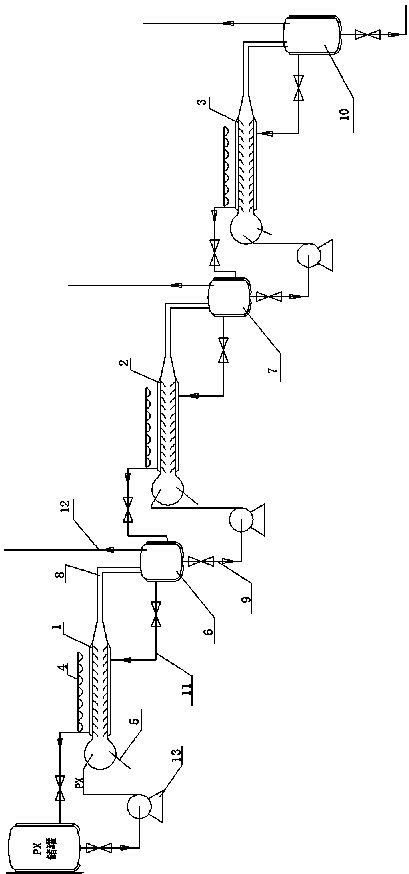New process for preparing p-xylylene dichloride by adopting novel reaction equipment
A technology of para-dichlorobenzyl and reaction equipment, applied in the field of preparing para-dichlorobenzyl, can solve the problems of low single-pass yield of dichlorobenzyl, low content of dichlorobenzyl, low reaction selectivity, etc., so as to reduce the generation of by-products , reduce the reaction temperature, the effect of high initiation efficiency
- Summary
- Abstract
- Description
- Claims
- Application Information
AI Technical Summary
Problems solved by technology
Method used
Image
Examples
Embodiment 1
[0043] A novel reaction equipment for preparing p-dichlorobenzyl includes a reactor, a gas-liquid separator, a crystallizer, and an LED lamp;
[0044] The outside of the reactor is fixed with an LED lamp 4, and the reactor is sealed with a chlorine gas inlet pipe 5;
[0045] The reactors are divided into three groups, which are respectively a first-stage reactor 1, a second-stage reactor 2, and a third-stage reactor 3;
[0046] The gas-liquid separator is divided into two groups, which are gas-liquid separator one 6 and gas-liquid separator two 7;
[0047] The gas-liquid separator one 6 is arranged between the first-stage reactor 1 and the second-stage reactor 2, and the first-stage reactor 1 is sealed and connected through the material pipeline 8, and the second-stage reactor 2 is sealed through the reaction liquid pipeline 9; The gas-liquid separator 2 7 is arranged between the second-stage reactor 2 and the third-stage reactor 3, and is sealed and connected to the second-s...
Embodiment 2
[0059] A total of 1000G p-xylene and 1210G chlorine gas are continuously pumped into the chlorinator with a high-pressure pump, and the reaction is initiated by an LED lamp. After a period of chlorine reaction, the material enters the gas-liquid separator to complete the reaction liquid and the hydrogen chloride gas generated by the reaction. After the gas-liquid separation, a reaction solution and chlorine gas are passed into the second-stage reactor, so that chlorine is divided into three sections, and the final reaction solution is sampled and tested (Table 1). The conversion rate of p-xylene is 97.75%, and p-dichlorobenzyl And the total selectivity to benzyl chloride is 99.01%, wherein the content of benzyl chloride is 74.65%. The third section of chlorinated material enters the crystallizer, and after gas-liquid separation and crystallization, the final product is obtained by filtration and separation, and the product content reaches 99.62%.
Embodiment 3
[0061] A total of 1000G p-xylene and 1170G chlorine gas are continuously pumped into the chlorinator with a high-pressure pump, and the reaction is initiated by an LED lamp. After a period of chlorine reaction, the material enters the gas-liquid separator to complete the reaction liquid and the hydrogen chloride gas produced by the reaction. After the gas-liquid separation, a reaction solution and chlorine gas are passed into the second-stage reactor, so that chlorine is divided into three sections, and the final reaction solution is sampled and tested (Table 1). The conversion rate of p-xylene is 96.49%, and p-dichlorobenzyl And the total selectivity to benzyl chloride is 99.09%, wherein the content of benzyl chloride is 70.04%. The third stage of chlorinated material enters the crystallizer, and after gas-liquid separation and crystallization, the final product is obtained by filtration and separation, and the product content reaches 99.59%.
[0062] Substance name ...
PUM
 Login to View More
Login to View More Abstract
Description
Claims
Application Information
 Login to View More
Login to View More - R&D
- Intellectual Property
- Life Sciences
- Materials
- Tech Scout
- Unparalleled Data Quality
- Higher Quality Content
- 60% Fewer Hallucinations
Browse by: Latest US Patents, China's latest patents, Technical Efficacy Thesaurus, Application Domain, Technology Topic, Popular Technical Reports.
© 2025 PatSnap. All rights reserved.Legal|Privacy policy|Modern Slavery Act Transparency Statement|Sitemap|About US| Contact US: help@patsnap.com


